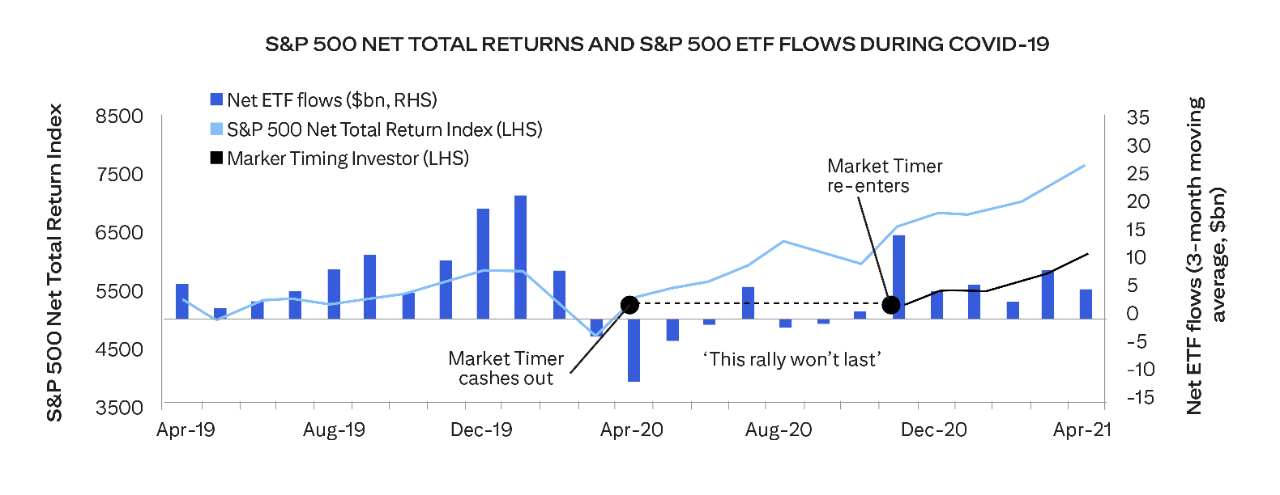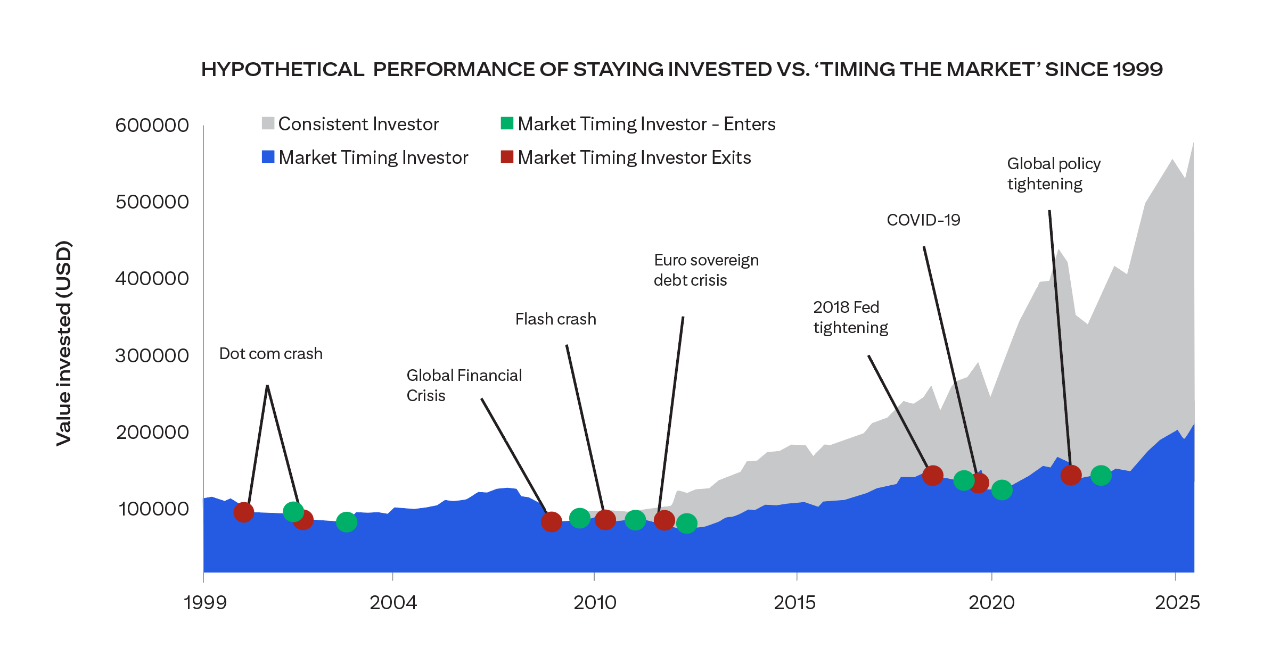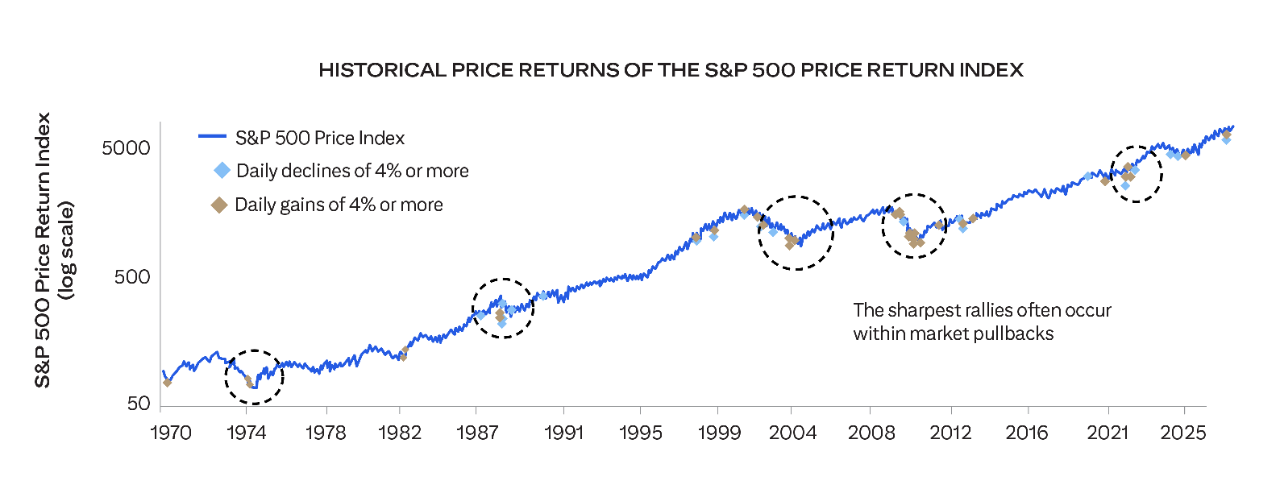SUMMARY
When conditions become volatile, it can be tempting to try to “time the market” by waiting to buy in cheaper or once a rally begins. However, history shows that investing like this can lead to long-term underperformance compared to remaining fully invested
Staying resolute to a plan
A key principle of long-term investing is staying resolute to a robust investment strategy, rather than reacting to or trying to anticipate short-term swings in financial markets.
In spring 2025, concerns over a possible US economic slowdown triggered a sharp bout of selling across some asset classes.
Such infrequent shocks can tempt some investors to deviate from their long-term investment plan. However, doing so can be detrimental to building long-term wealth.
Timing the market doesn't work
Especially when markets are volatile, it can be tempting to try to “time the markets,” i.e., switching between risk assets and cash in a bid to dodge downtrends and ride rallies.
As alluring as this may seem, experience says that this approach can be costly in terms of performance.
The chart below shows the behavior of S&P 500 exchange traded fund (ETF) investors during the COVID-19 selloff in 2020.
The strongest selling – or outflows – in ETFs occurred around the time the S&P 500 was finding its lows.
The strongest buying (inflows) following this episode occurred only after significant gains had already occurred, suggesting that many of those who left the market re-entered but “too late” and missed out on positive returns that they would have enjoyed had they stayed invested.
This pattern of both getting out and getting back in too late is common during down markets. And it is a recipe for long-term underperformance.1
S&P 500 Net total returns and S&P 500 ETF flows during Covid-19

Source: Citi Wealth Investment Lab, Bloomberg. Data from 1 April 2019 to 30 April 2021.1 The blue solid and dotted lines above shows the returns from cashing out of the S&P 500 Net Total Return Index at the date of the greatest ETF outflows (April 2020) and reinvesting at the date of the greatest ETF inflows during the subsequent rally (November 2020).
Trying to 'time' the S&P 500 index
We show this by examining the hypothetical performance of a ‘Consistent Investor’ and a ‘Market Timer’ who each invest a hypothetical $100,000 into the S&P 500 index on 31st December 1999, near the peak of the dotcom bubble. The Consistent Investor then simply stays invested.
The Market Timer shift entirely into cash - 3-month Treasury bills - whenever the S&P 500 index falls by 10% or more in a quarter and then re-enters only after two consecutive quarters of positive returns.
We see that the forgone returns from trying to time markets add up over time. The Consistent Investor has outperformed the Market Timer by 191% since 1999.2 Sitting on the side-lines and waiting for a clear recovery could mean missing opportunities and long-term underperformance compared to being invested.
Hypothetical performance after inflation of staying invested vs. ‘timing the market’ since 1999

2Source: Citi Wealth Investment Lab using Bloomberg. Quarterly data from 31 December 1999 to 27 June 2025. The Consistent Investor is invested into Equities throughout. Market Timing Investor begins invested into Equities but switches into Cash if Equities fall by 10% or more in a quarter and invests back into Equities only after 2 successive quarters of positive performance by Equities. Equities is the S&P 500 net total return index. Cash is constructed using the 3-month US government bond yield index Index.
Turning points are hard to identify
Timing the market can be costly because identifying market highs and lows is difficult. Many prominent approaches to market timing only reenter the market once a condition is met, such as the index recovering to or near to a past high or crossing a long-term moving average. These tactics are a common reason for market timers missing out on the strong early-stage gains that can accompany a new bull market or renewal of an uptrend.
Historical price returns of the S&P 500 price return Index

Source: Citi Wealth Investment Lab using. Bloomberg using daily data from 2 January 1970 to 27 June 2025.
KEY TAKEAWAYS
Being invested can be a way to meet investing goals over the long term. However, uncertain market conditions often lead investors to exit the market and remain uninvested until a recovery appears to be clear.
ETF investment flows suggest that investors often fail at market timing – waiting until both downturns and then recoveries are clearly established, and in this way exiting the market ‘too late’ near the bottom, and also re-entering ‘too late’ and missing much of the recovery.
History shows that this isn’t surprising given that the best and worst days for market performance often occur close together, with some of the strongest performances occurring during overall market downturns.
Over time the opportunity costs (compared to remaining invested) of such mis-timing can compound and lead to significant underperformance compared to a strategy of staying invested.










